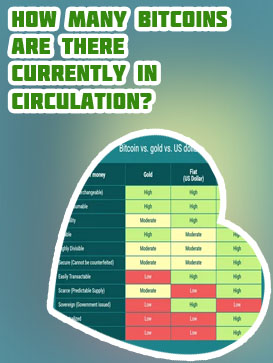
How many bitcoins exist
Post as a guest
A pre-defined schedule limits the total number of bitcoins so that they gradually approach a total of 21 million (ignoring those that have been lost through deleted or misplaced wallet files). The limit of 21 million bitcoins is "hard-wired" in to the protocol, and there will never be more bitcoins than this: How many bitcoins are in existence The current distribution is based on date in time, and this article was written in February 2023. Recent studies from the National Bureau of Economic Research and the University of Limerick suggest that Bitcoin's distribution is concentrated in the hands of a few whales. According to blockchain analysts, approximately 6,952 BTC wallets control 58.21% of available bitcoins, which means about 0.01% of the total BTC holders have almost 60% of BTC's supply.

How many bitcoin are in circulation
Bitcoin future: What’s next for the top crypto?
We mentioned above that the current circulating supply of Bitcoin is 19,418,512 BTC. This figure also refers to the number of Bitcoins that have been mined. As such, 100% of Bitcoin tokens in circulation were originally distributed to miners. In turn, the general public can only buy Bitcoin once the newly mined tokens are sold. Miners must sell their Bitcoin at some point, as they are in business to make money. And the only way to realize their mining profits is to sell their Bitcoin on the open market. If the miner has sufficient resources, they might look to sell their Bitcoin at strategic intervals. This means that they might not sell their Bitcoin until prices are sufficient. Why Bitcoin’s Hard Cap Will Not Change? Pricing
How many bitcoins will there be
- Is cryptocom available in new york
- Ethereum crypto
- Buy btc with credit card
- Bitcoincom exchange
- Create cryptocurrency
- How do you buy cryptocurrency
- Buy baby dogecoin
- What the hell is bitcoin
- Btc price converter
- Lightcoin price usd
- Best sites to buy cryptocurrency
- Types of bitcoins
- Selling crypto
- Cryptos
- Cryptocom app review
- Safemoon crypto com
- How many btc are there
- Bitcoin's value today
- Buy crypto with credit card
- Crypto exchange
- Gas fees eth
- Is crypto com down
- Cryptocom headquarters
- Crypto pc
- Cryptocurrency apps
- Cryptocom cards
- Cryptocom sell to fiat wallet
- Dogecoin to a dollar
- Who created bitcoin
- Where to buy crypto
- Btc live price
- Learn cryptocurrency
- Cryptocom news
- Bitcoin starting price
- Cryptocurrency bitcoin price
- Crypto com not working
- Eth max price
- Cryptocurrency prices
- Where to buy new crypto coins
- Cryptocom card
- Cryptocoin com coin
- Bitcoin spot
- Is transferring crypto a taxable event
- How to withdraw money from cryptocom
- Crypto wallet app
- To invest all profits in crypto
- Bitcoin halving price prediction
- Bitcoin cryptocurrency
- Bitcoin price usd prediction
- Litecoin
- Litecoin price today
- When to sell crypto
- Dogecoin converter
- When to buy bitcoin